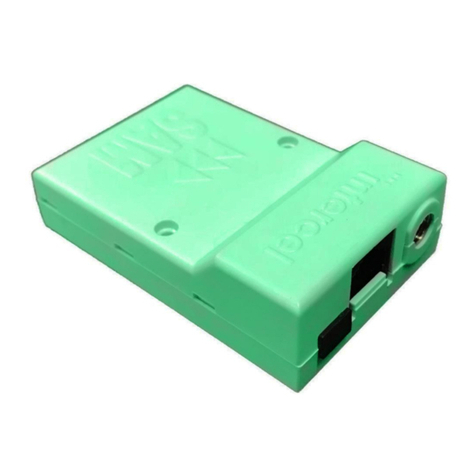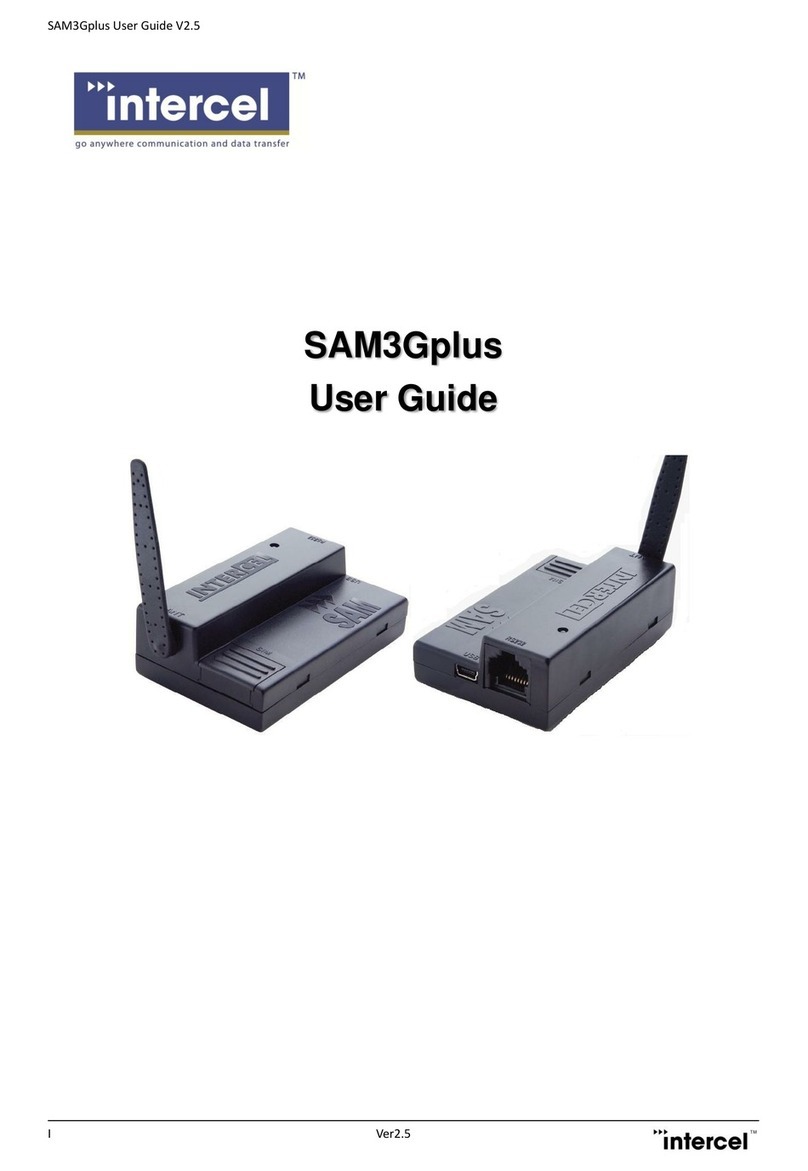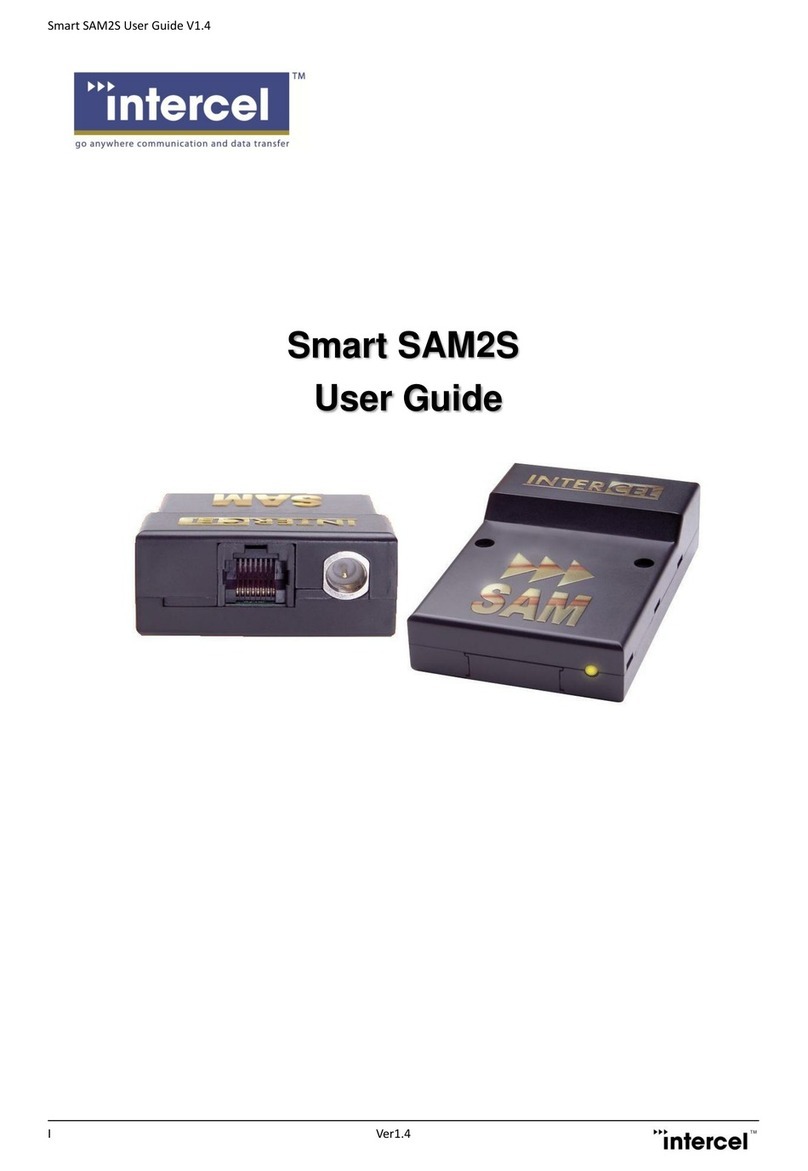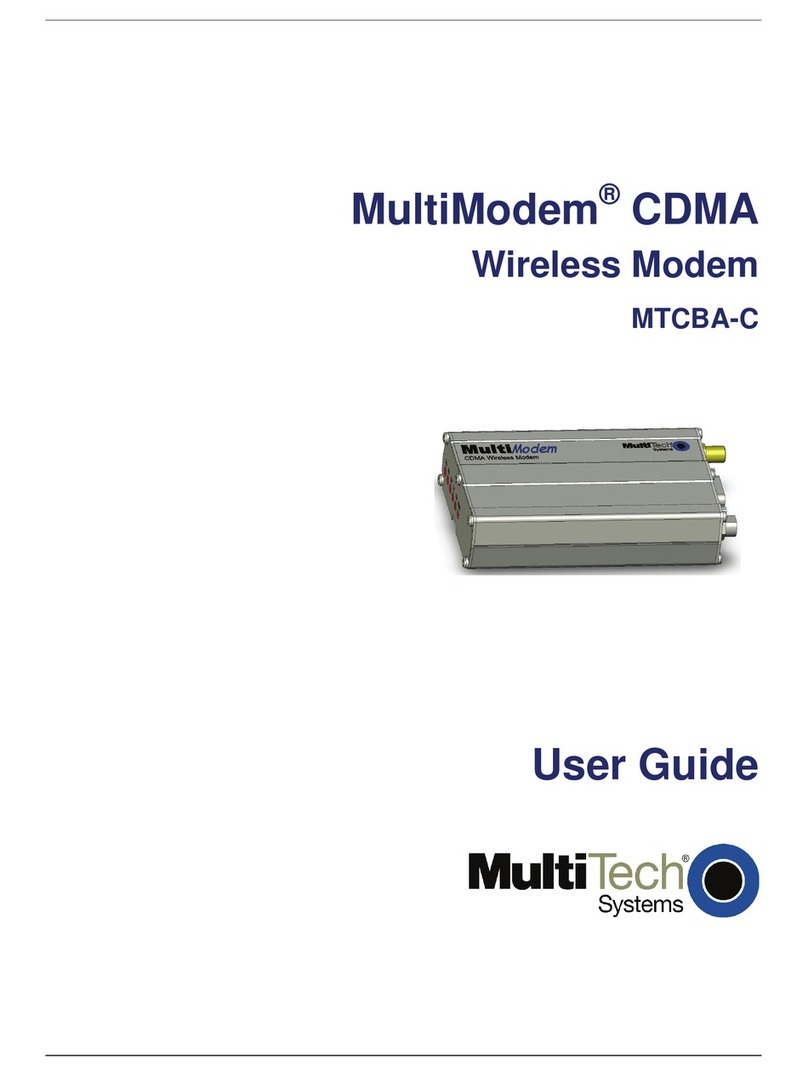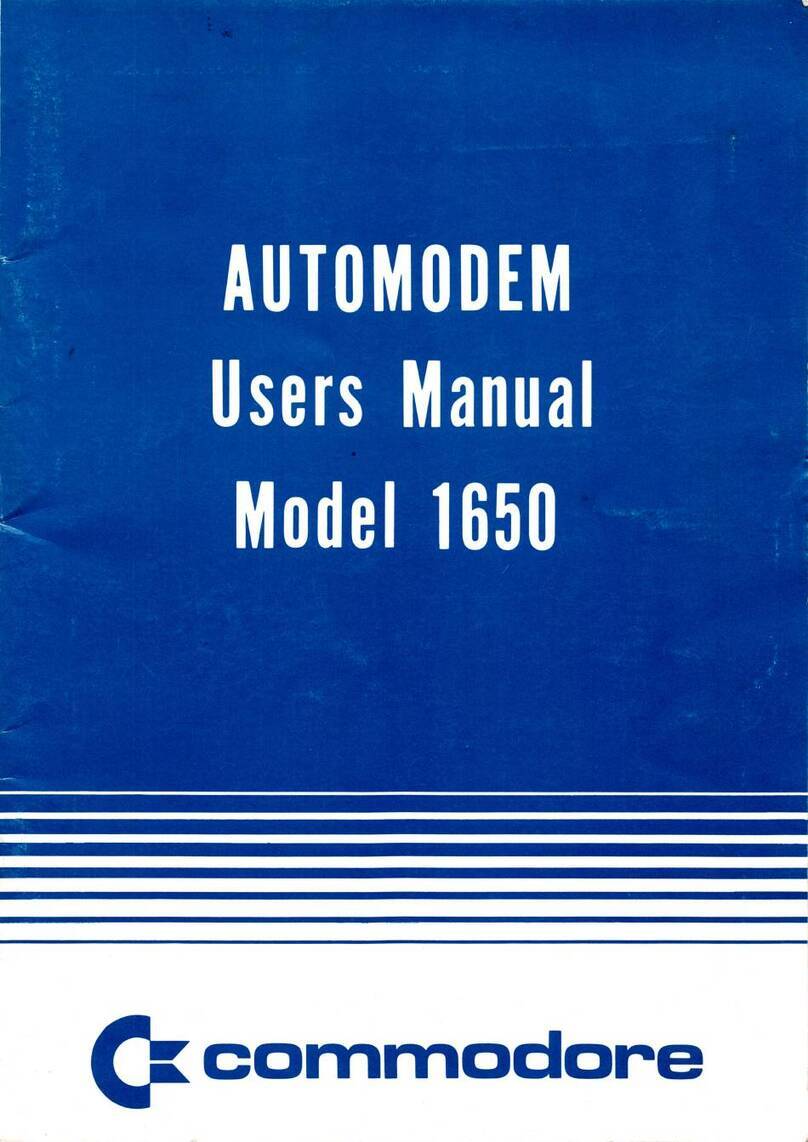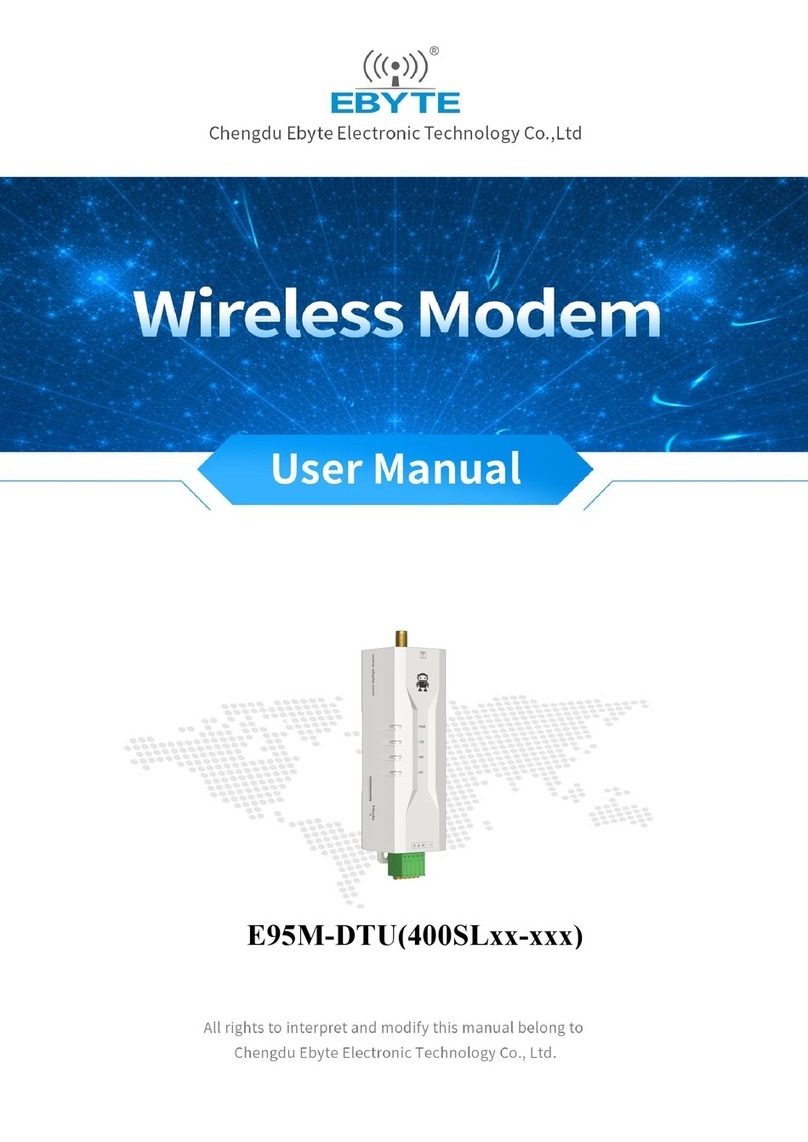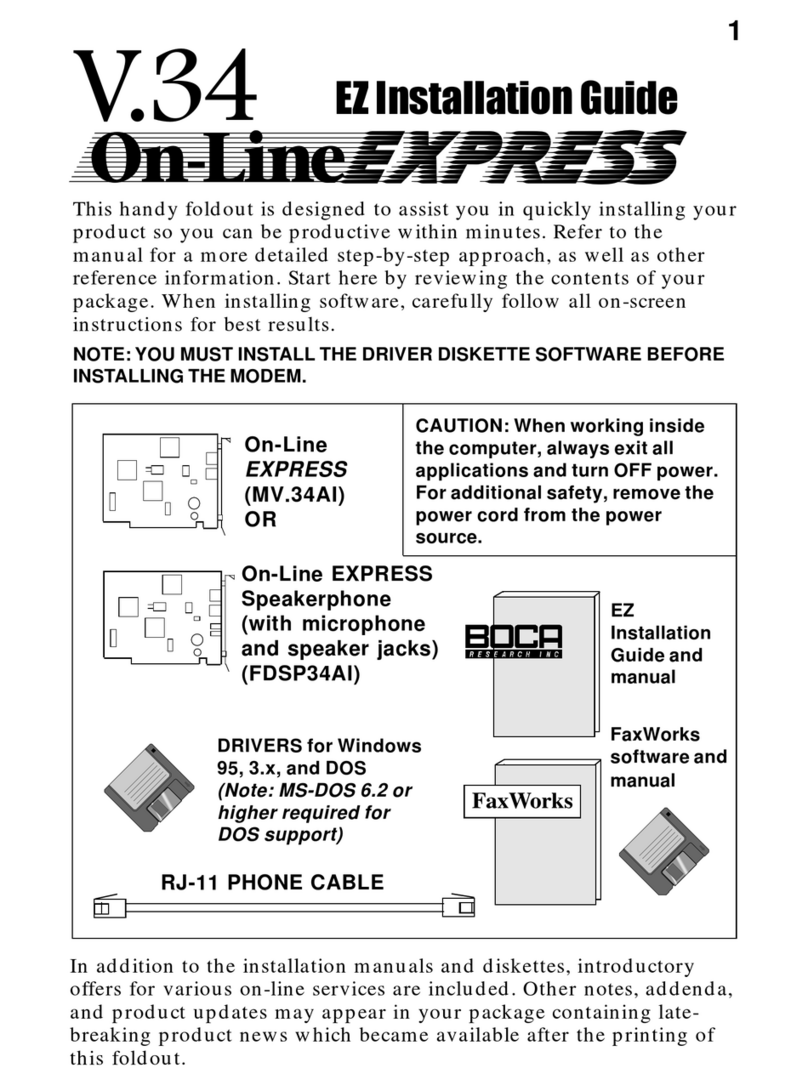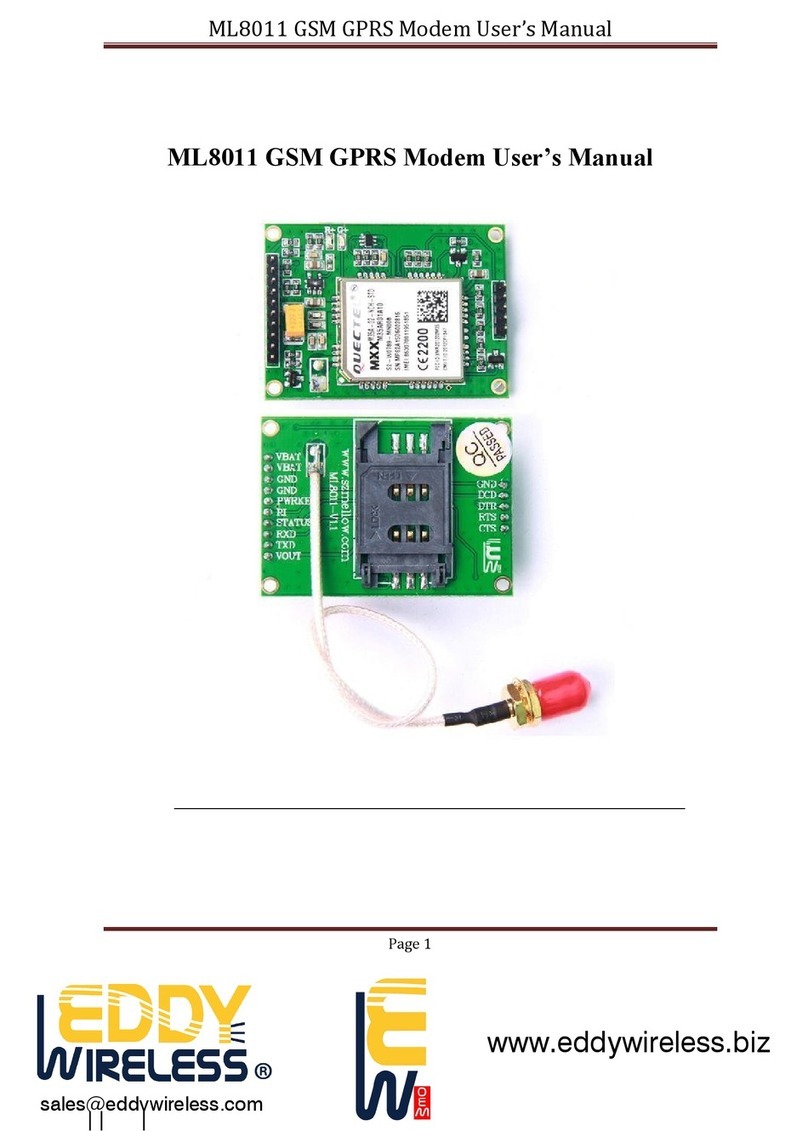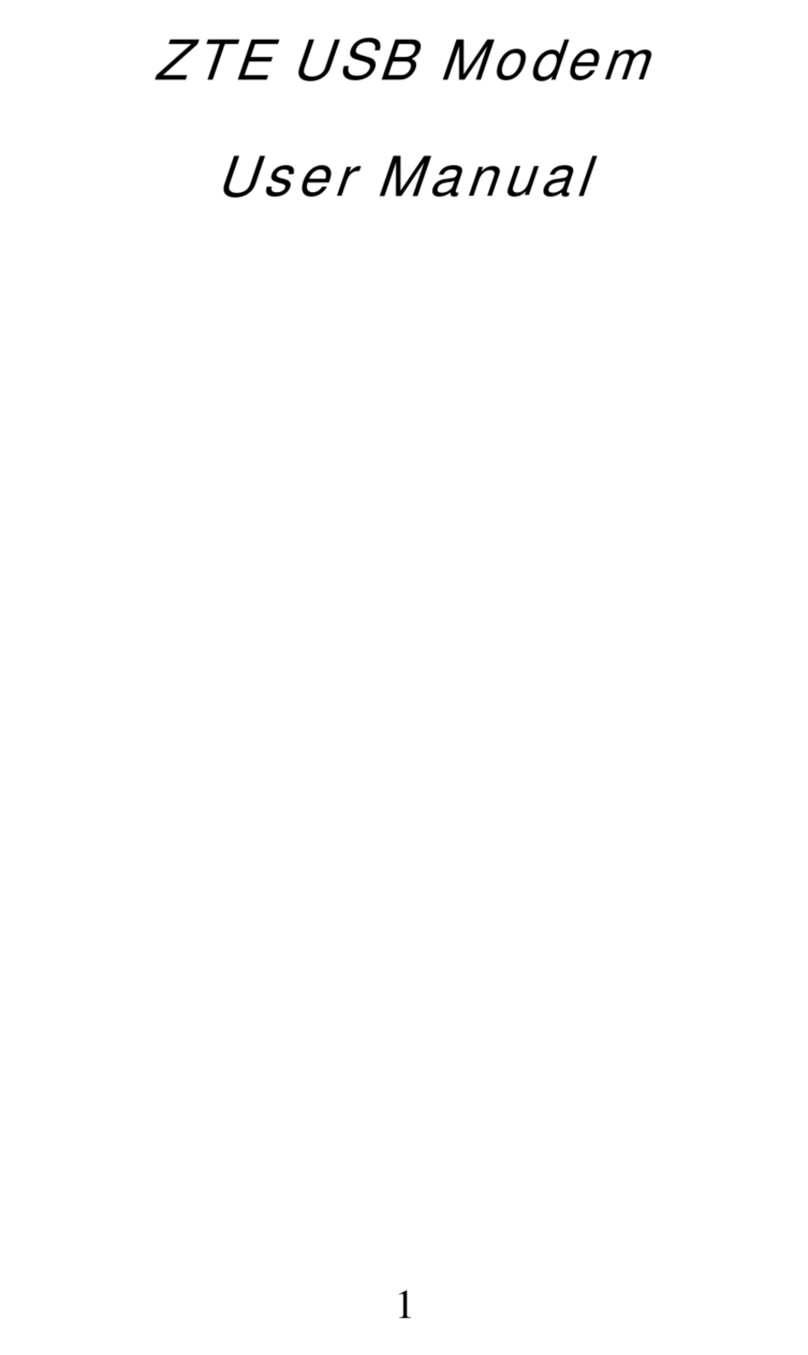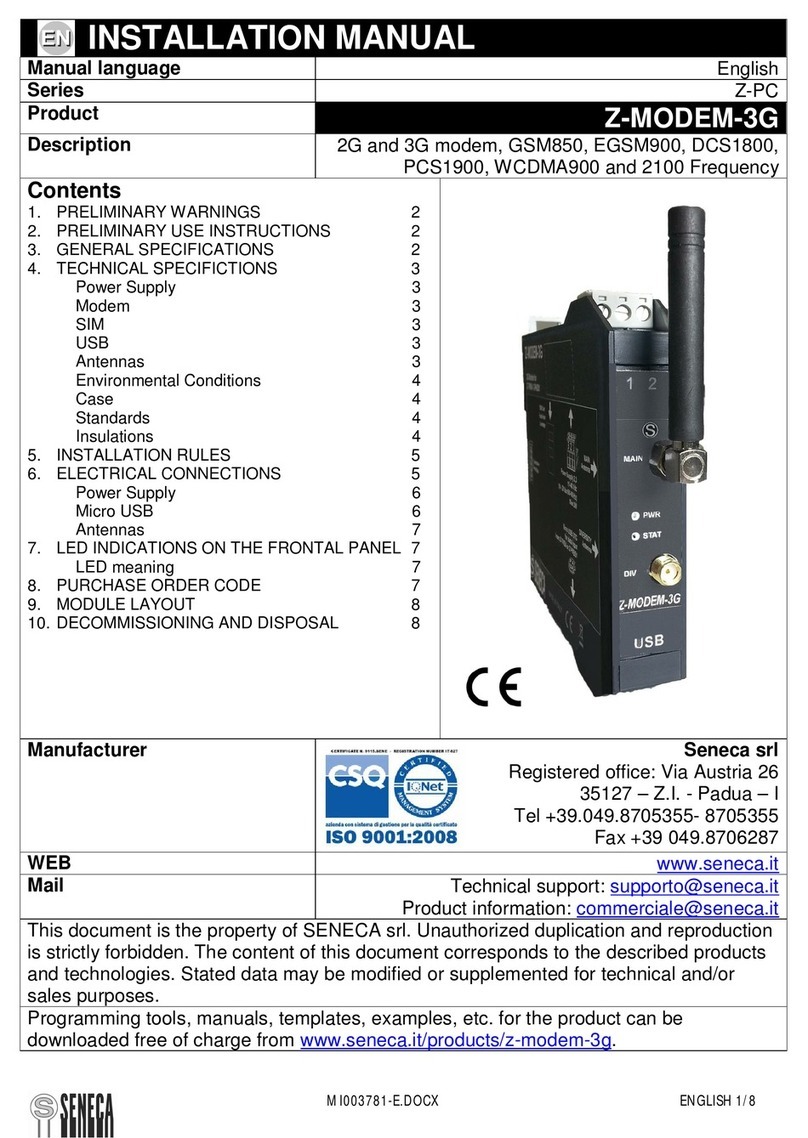Intercel SAMXT User manual

SAMXT User Guide
V1.5

Version
Modified By
Date
Description
1.0
29/10/2018
Initial version
1.1
Van Pham
30/11/2018
Minor adjustments and name update
1.2
Sang Vu
19/02/2019
Modem enclosure photo updated
1.3
Moe Chaudhry
02/09/2019
New format
1.4
Moe Chaudhry
12/09/2019
Production label change
1.5
Van Pham
16/09/2019
Updated AT commands & module reference
Revision History

1
SAMXT User Guide V1.5
Contents
1 Introduction...............................................................................................................................................................2
Safety Precautions......................................................................................................................................................3
3 Radio Frequency Exposure - SAR........................................................................................................................4
4 WEEE Directive 2002/96/EC, Disposal of old Electronic Equipment...............................................................5
5Packing................................................................................................................................................................6
5.1 Content...........................................................................................................................................................6
5.2 Packaging Box .................................................................................................................................................6
5.3 Production Label..............................................................................................................................................7
6 Functionality .............................................................................................................................................................8
6.1 General..............................................................................................................................................................8
6.2 RJ45 Socket .....................................................................................................................................................9
6.3 FME-Male 50Ω Antenna Connectors............................................................................................................9
6.4 SIM Holder........................................................................................................................................................9
6.5 LED Status......................................................................................................................................................10
6.6 Data Cable......................................................................................................................................................12
7 Electrical Characters.............................................................................................................................................13
7.1 Power Consumption......................................................................................................................................13
7.2 Receive Sensitivity.........................................................................................................................................13
7.3 Conducted Transmit Power..........................................................................................................................14
7.4 Antenna Specifications..................................................................................................................................14
7.5 Environmental Characteristics.....................................................................................................................14
8 The SAMXT TCP/IP Operation............................................................................................................................15
8.1 Communication Sockets...............................................................................................................................15
8.2 TCP/IP AT$ Commands ..............................................................................................................................16
9 Firmware Upgrade.................................................................................................................................................27
9.1 The LTE Module Firmware...........................................................................................................................27
9.2 The Modem’s Controller Software...............................................................................................................27
Note.............................................................................................................................................................................28

2
SAMXT User Guide V1.5
1 Introduction
The SAMXT is a compact, light-weight, LTE based modem. It provides CATM1, 3GPP Release
13 compliant with the uplink speed of (up to) 375Kbps and downlink speed of (up to) 300Kbps in
Cat M1 Mode.
The SAMXT is designed for both mobile and fixed M2M applications. It has an RJ45 socket for
input voltage and the serial RS232 signals, one FME-male for main antenna connection, a SIM
holder and an LED indicator.
The SAMXT is controlled by a set of AT commands.
USB port Main Antenna LED Mini-SIM compartment
RJ45 socket for input power and serial RS232
Mobile station engine ME910C1-AU
EU approval CE-1909
3GPP Release 13 (CAT M1)
RCM tick mark

3
SAMXT User Guide V1.5
2 Safety Precautions
The following safety precautions must be observed whenever the SAMXT modem is in
operation or in service. Failure to comply with these precautions violates the safety standards of
the design, manufacture and intended use of the product
- Switch off the SAMXT modem:
•In hospitals or places where medical equipment may be in use
•In an aircraft
•Refueling points
•Explosive areas
- Restricted use of the SAMXT modem:
•Near any chemical plant
•Near any fuel depot
•Areas with mobile phone warning signs
Respect national regulations on the use of cellular devices.
The SAMXT modem receives and transmits radio frequency energy while switched on,
therefore interference can occur if the SAMXT is near TVs, radios, PCs or any inadequately
shielded equipment.

4
SAMXT User Guide V1.5
3 Radio Frequency Exposure - SAR
The SAMXT modem is a low-power transceiver, similar to a typical handheld 3G/LTE mobile
phone. When it is turned on, it will emit low-level radio frequency energy.
There are different guidelines and standards around the world that govern the permitted levels
of radio frequency exposure for general population. The levels include a safety margin to a
human body.
The Specific Absorption rate (SAR) is a measure of the rate at which radio frequency energy is
absorbed by the body when exposed to radio frequency electromagnetic field. The SAR value is
determined at the highest certified power level in the laboratory conditions, but the actual SAR
level of the transceiver while operating can be well below this value. This is because the
transceiver is designed to use minimum power to connect to the network.
The SAMXT modem is approved to use in applications where the antenna is placed more
than 21cm from the body.
For other applications, the integrator is responsible for the local SAR requirements.

5
SAMXT User Guide V1.5
4 WEEE Directive 2002/96/EC, Disposal of old Electronic
Equipment
This symbol on the product indicates that this product shall not be treated as
household waste. It must be placed at an appropriate collection point for the recycling of
electrical and electronic equipment.
By ensuring the correct disposal of this equipment, it will help the environment and human
health. Recycling will also help to conserve natural resources.
The SAMXT product is RoHS compliant

6
SAMXT User Guide V1.5
5Packing
5.1 Content
The SAMXT package consists of:
- SAMXT Modem
- Data Cable
The SAMXT User Guide is available at www.intercel.com.au
5.2 Packaging Box
The carton box diameter is 120mm x 95mm x 60mm
The data cable is 2m long
The label diameter is 50mm x 33mm
A suitable power supply is available on request. The SAMXT must be powered using a limited
power source of 12V/1A power supply according to the clause 2.5 of AS/NZS 60950.1.
A suitable antenna is also available on request. Please make sure the correct antenna is used
to get optimized performance from the SAMXT.

7
SAMXT User Guide V1.5
5.3 Production Label
The production part number is located at the back of the SAMXT, which includes:
- Product Model
- Software Version
- Hardware Version
- IMEI Number
- Manufacturer
- Part Number

8
SAMXT User Guide V1.5
6 Functionality
6.1 General
The SAMXT modem consists of an RJ45 socket for serial port and input power, a SIM holder
and an FME male connector for main antenna. The LED indicator, located next to the SIM
holder, indicates the SAMXT operating status.
Main antenna
Telit ME910C1-AU
LTE ENGINE
Switching
Power
Supply
RS232
Serial
Data
Interface
SIM Interface
RJ45
Socket
LED
Indicator
The SAMXT Functional Block Diagram
ARM
Cortex M3
Serial Data
switches

9
SAMXT User Guide V1.5
6.2 RJ45 Socket
Pin Signals Description
1 VIN Input voltage 5Vdc - 32Vdc
2 DCD Data Carrier Detect
3 DTR/RI Data terminal Ready/Ring Indicator
4 GND Common Ground
5 RXD Serial Data out of the SAMXT
6 TXD Serial Data into the SAMX3
7 CTS Clear to Send
8 RTS Ready to Send
6.3 FME-Male 50Ω Antenna Connectors
The FME male antenna connector is a 50Ω impedance antenna connector. The antenna used
for the SAMXT must have 50Ω impedance.
6.4 SIM Holder
The SIM holder is designed to accommodate a mini-SIM card. The SIM card can either be 3V or
1V8 SIM. To insert the SIM card, remove the door by sliding it back towards the end. Make sure
the SIM card faces the right way as indicated on the box. Voltage levels over this SIM interface
complies with 3GPP standards.

10
SAMXT User Guide V1.5
6.5 LED Status
The LED indicator has the following status for different SAMMODE:
SAMMODE=0
LED behaviour can be set by AT#SLED=<mode> [,<on_duration>[,<off_duration>]]
Default is <mode> = 2 with the following timings:
• Not registered: always on
• registered in idle: blinking 1s on and 2s off
• registered in idle with power saving: blinking time depends on network condition in order to
minimize power consumption
SAMMODE=1
Modem power on until SIM ready: Red LED On
Modem initialize on NB1: Red LED 1s On/Off
Modem initialize on M1: Red LED 500ms On/Off
Remote socket connection on NB1: Orange LED 500ms On/Off
Remote socket connection on M1: Green LED 500ms On/Off
Modem failed to connect to IP: Red LED 100ms On/Off
Modem connected to IP: Green LED flashing on M1, Orange LED flashing on NB1, LED timing
patterns are explained below.
On M1 RSRP Signal Strength
> -90 dBm 4 pulses of Green LED (100ms On 300ms Off) then 3s Off
-90 dBm to -105 dBm 3 pulses of Green LED (100ms On 300ms Off) then 3s Off
-106 dBm to -120 dBm 2 pulses of Green LED (100ms On 300ms Off) then 3s Off
< -120 dBm 1 pulse of Green LED (100ms On 300ms Off) then 3s Off
On NB1 RSRP Signal Strength
> -90 dBm 4 pulses of Orange LED (100ms On 300ms Off) then 3s Off
-90 dBm to -105 dBm 3 pulses of Orange LED (100ms On 300ms Off) then 3s Off

11
SAMXT User Guide V1.5
-106 dBm to -120 dBm 2 pulses of Orange LED (100ms On 300ms Off) then 3s Off
< -120 dBm 1 pulse of Orange LED (100ms On 300ms Off) then 3s Off
If modem is IP connected in idle state but is searching for network or is of limited service: Red
LED flashing, LED timing patterns are explained below.
RSRP Signal Strength
> -90 dBm 4 pulses of Red LED (100ms On 300ms Off) then 3s Off
-90 dBm to -105 dBm 3 pulses of Red LED (100ms On 300ms Off) then 3s Off
-106 dBm to -120 dBm 2 pulses of Red LED (100ms On 300ms Off) then 3s Off
< -120 dBm 1 pulse of Red LED (100ms On 300ms Off) then 3s Off
FOTA (M1/NB1 module Firmware Over The Air upgrade) or DOTA (Modem software Download
Over the Air upgrade):
Process run on NB1: Orange LED 100ms On/Off
Process run on M1: Green LED 100ms On/Off

12
SAMXT User Guide V1.5
6.6 Data Cable
The data cable is 2m long. It consists of an RJ45 plug, a DB9-female connector and a 4 pin
micro-fit termination.
5 4 3 2 1
9 8 7 6
DB9 Signals RJ45 Description
1 DCD 2 Data Carrier Detect
2 RXD 5 Serial Data out of the SAMXT
3 TXD 6 Serial Data into the SAMXT
4 DTR 3 Not used
5 GND 4 Common Ground
6 DSR
7 RTS 8 Ready to Send
8 CTS 7 Clear to Send
9 RI Not used
1 RED wire : Input voltage from 5Vdc to 32Vdc
4 BLACK wire : Power Ground

13
SAMXT User Guide V1.5
7 Electrical Characters
7.1 Power Consumption
Idle mode 30mA @12V
Average in-use mode 80mA@12V
Full Tx power 90mA@12V
Peak current requirement 0.3A@12V
7.2 Receive Sensitivity
Measurement setup:
(LTE) CAT M1 Throughput >95% According to 3GPP 36.521-1
(LTE) CAT NB1 Throughput >95% According to 3GPP 36.521-1
REF Sensitivity (dBm)
3GPP REFSens (dBm)
MODE/BAND
CAT M1 / Band 3
CAT M1 / Band 5
CAT M1 / Band 8
CAT M1 / Band 28
-108 dBm
-108.8 dBm
-108.4 dBm
-108 dBm
-99.3 dBm
-100.8 dBm
-99.8 dBm
-100.8 dBm
CAT NB1 / Band 3
CAT NB1 / Band 5
CAT NB1 / Band 8
CAT NB1 / Band 28
-115.6 dBm
-114.6 dBm
-113.8 dBm
-115.2 dBm
-107.5 dBm
-107.5 dBm
-107.5 dBm
-107.5 dBm

14
SAMXT User Guide V1.5
7.3 Conducted Transmit Power
7.4 Antenna Specifications
Max cable loss 0.5dBm
Impedance 50Ω
VSWR recommended 2:1
VSWR absolute maximum 10:1
7.5 Environmental Characteristics
Operating temperature -30°C to +85°C
Storage temperature -40°C to +95°C
Humidity 90% relative humidity (non-condensing)
Band
Mode
Class
RF power (dBm)
All Bands
All Bands
(LTE) CAT-M1
3
23 (±2 dB)
(LTE) CAT-NB1
3
23 (±2 dB)

15
SAMXT User Guide V1.5
8 The SAMXT TCP/IP Operation
The SAMXT has an MCU (Microcontroller) to control the LTE module ME910C1-AU. The
SAMXT can be operating in three different modes, defined by the parameter SAMMODE:
-SAMMODE=0. The modem is in standard mode. When powered on, the MCU turns on the LTE
module, checks its baud rate, turns on the LED and releases control of the LTE module to the
connecting device. AT commands can be sent from the serial port here after, the MCU will keep
monitoring the LTE module Rx pin for AT$ commands and checks time in the RESETPERIOD
parameter to reset itself and the LTE module.
-SAMMODE=1. The modem is in PSD (Packet Switch Data) smart mode. The MCU is in total
control of the LTE module. When powered on the software reads all parameters from flash and
activates a PSD connection, it then creates a UDP and a TCP socket to listen for data transfer
connection, opens a UDP and a TCP socket to listen for remote AT commands connection. If
programmed as a TCP client it will try to connect to a remote TCP server, the modem then stays
in PSD online idle state waiting for SMS, UDP or TCP connection. The software maintains PSD
connectivity by means of PING using POLLPERIOD parameter stored in flash.
8.1 Communication Sockets
TCP Data: The socket connection allows transparent data (excluded IP header) to pass
through from the remote host to the modem serial port and vice versa. In TCP
server mode, the socket will be disconnected after 5 minutes of no data transfer.
UDP Data: The socket connection allows transparent data to pass through from the remote
host to the modem serial port and vice versa. A block of data received from a
remote UDP server will open a 2 minutes window for data to be transferred from
the serial port.
TCP AT Command: The socket connection allows a user from the host computer to send AT
commands to the modem and receive its responses. The socket will be
disconnected after 5 minutes of no activity. The socket can also be used for
remote firmware update.
UDP AT Command: The socket connection allows a user from the host computer to send AT
commands to the modem and receive its responses. The socket can also be
used for remote firmware update.
.

16
SAMXT User Guide V1.5
8.2 TCP/IP AT$ Commands
Communications parameters are stored in Flash using AT$PARAMETERS.
Parameters are defined as:
APN=Access Point Name
USERNAME=Username that may be required with GPRS login
PASSWORD=Password that may be required with GPRS login
LTCPPORT=Local TCP listening port
RTCPIP=Remote TCP server IP
RTCPPORT= Remote TCP server port
TCPMODE=0 or 1 (0 to disable the modem TCP client, 1 to enable the modem TCP client)
LUDPPORT=Local binding UDP port (modem listens for UDP data on this port)
RUDPIP=Remote binding UDP IP (modem only accepts data from this IP)
RUDPPORT=Remote binding UDP port (modem sends UDP data to this port)
PINGIP=If set, the modem will send PING packet to this IP to check for PSD connectivity.
POLLPERIOD=Modem uses this time to send TRACE or PING packet to check for PSD
connectivity.
RESETPERIOD=Set time to reset modem periodically.
SBREAKTIME=Serial port break time, modem will wait for this break in serial port transmission
before it packetizes the data and sends.
MBREAKTIME=Modem or GSM module serial break time, use to adjust the way the modem
rebuilds long IP packets from fragments of CMUX frames.
BAUDRATE=Serial port baud rate.
DATALEN=Serial port data bits 7 or 8
PARITY= NONE or ODD or EVEN
SAMMODE=0 for standard modem, 1 for PSD mode.
SERIALLOCK= When modem access is safeguarded by username and password, 0=serial port
access is not lock, 1=serial port access is locked

17
SAMXT User Guide V1.5
LOGINTIMEOUT=Timeout (in seconds) after repeated failed login attempts (set at 5 failed
attempts).
SESSIONIDLETIME=Set the time interval (in seconds) the login session could stay idle before it
is closed
PPPAUTH=PAP or CHAP for PPP authentication, PAP is the default value.
All parameters can be programmed all at once.
AT$PARAMETERS=APN=telstra.extranet,USERNAME=intercel,PASSWORD=mach,LTCPPOR
T=10000,RTCPIP=203.45.1.236,RTCPPORT=10000,TCPMODE=,LUDPPORT=20000,RUDPIP
=203.45.1.236,RUDPPORT=20000,POLLPERIOD=60,SBREAKTIME=100,MBREAKTIME=5,B
AUDRATE=115200,DATALEN=8,PARITY=NONE,SAMMODE=0,SERIALLOCK=0,LOGINTIME
OUT=300,SESSIONIDLETIME=120,
PPPAUTH=PAP
Saved parameters to flash...
OK
Or a few parameters or one at a time.
AT$PARAMETERS=APN=telstra.extranet,USERNAME=intercel,PASSWORD=mach
Saved parameters to flash...
OK
AT$PARAMETERS=LTCPPORT=10000,RTCPIP=203.45.1.236,RTCPPORT=10000,TCPMOD
E=,LUDPPORT=20000,RUDPIP=203.45.1.236,RUDPPORT=20000
Saved parameters to flash...
OK
AT$PARAMETERS=POLLPERIOD=60,SBREAKTIME=100,MBREAKTIME=5,BAUDRATE=115
200,DATALEN=8,PARITY=NONE
Saved parameters to flash...
OK
AT$PARAMETERS=SAMMODE=0
Saved parameters to flash...
OK

18
SAMXT User Guide V1.5
AT$PARAMETERS?
$PARAMETERS:
APN: telstra.extranet
USERNAME: intercel
PASSWORD: mach
LTCPPORT: 10000
RTCPIP: 203.45.1.236
RTCPPORT: 10000
TCPMODE: 0
LUDPPORT: 20000
RUDPIP: 203.45.1.236
RUDPPORT: 20000
BAUDRATE: 115200
DATALEN: 8
PARITY: NONE
POLLPERIOD: 60
RESETPERIOD: 1440
SBREAKTIME: 100
MBREAKTIME: 5
SERIALLOCK: 0
LOGINTIMEOUT: 300
SESSIONIDLETIME: 120
PPPAUTH: CHAP
SAMMODE: 0
OK
Table of contents
Other Intercel Modem manuals
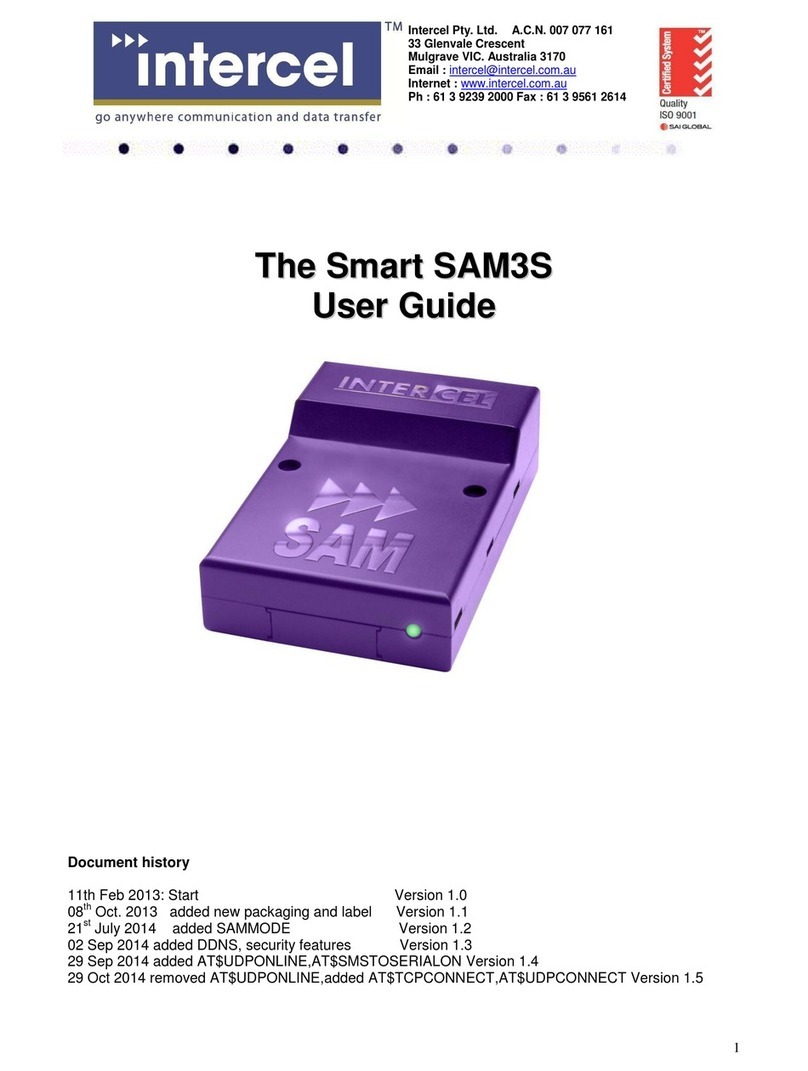
Intercel
Intercel Smart SAM3S User manual
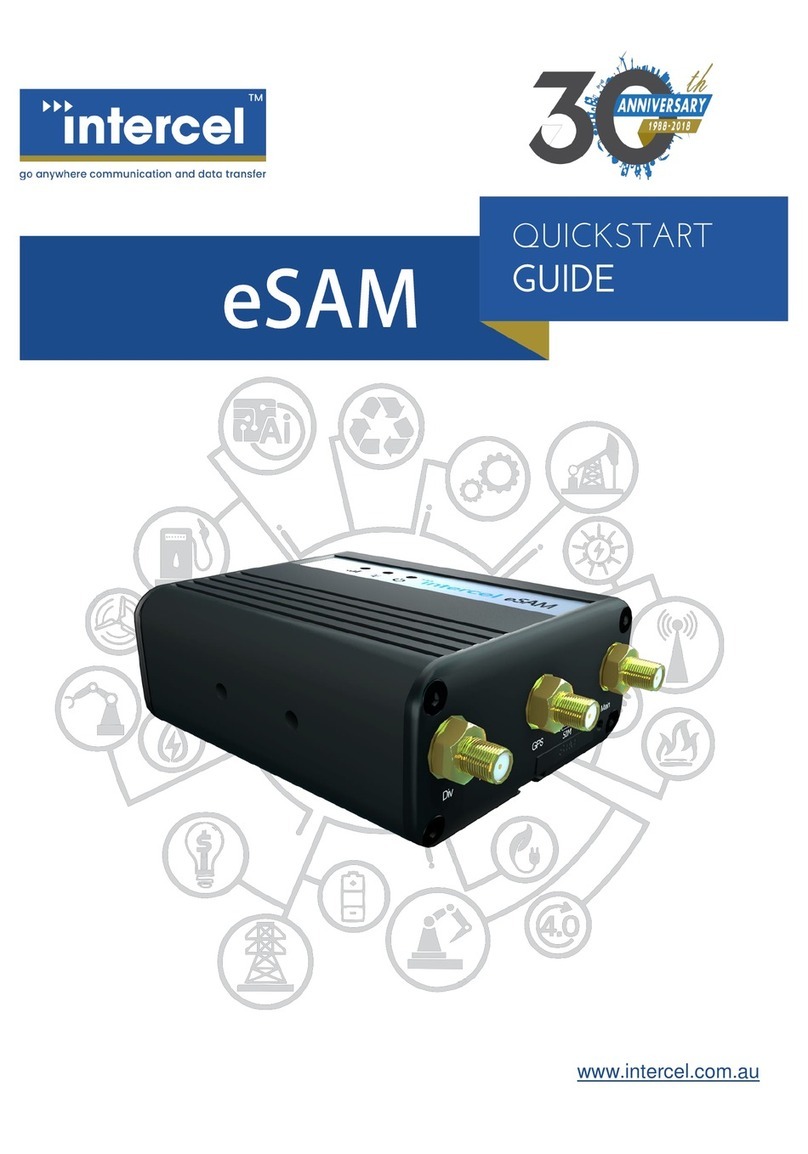
Intercel
Intercel eSAM User manual
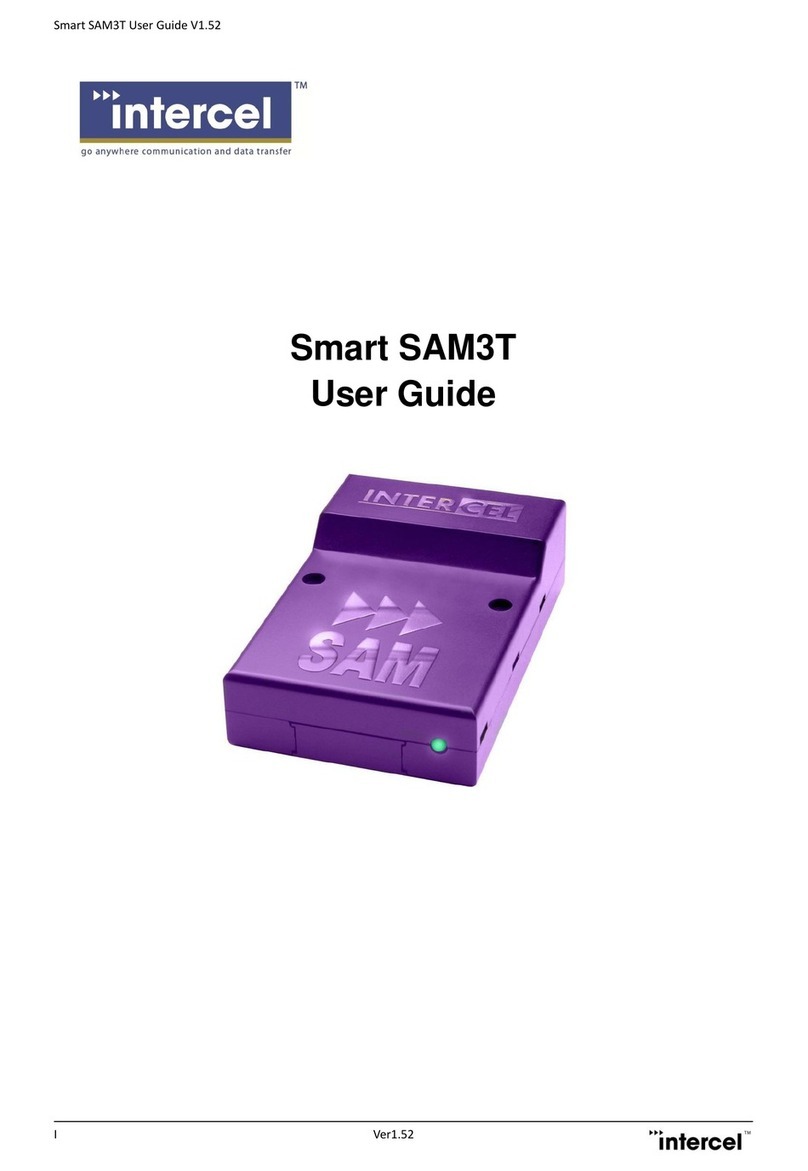
Intercel
Intercel SAM3T User manual
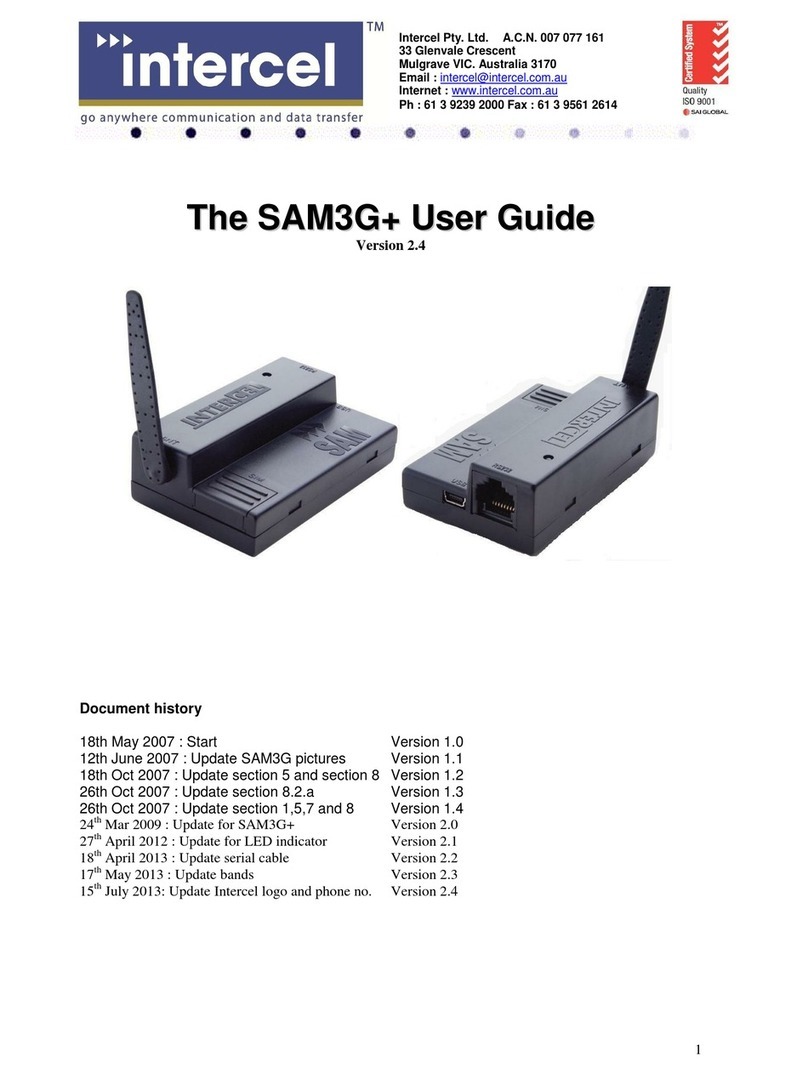
Intercel
Intercel SAM3G+ User manual
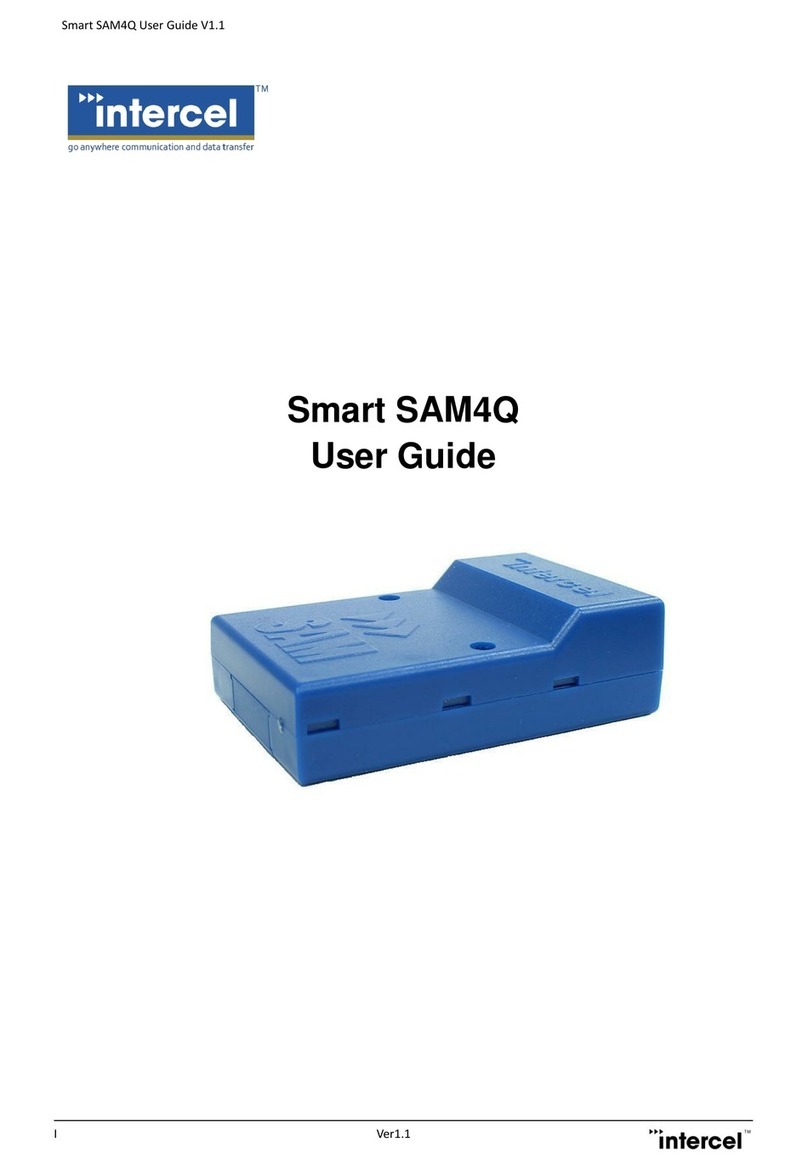
Intercel
Intercel Smart SAM4Q User manual
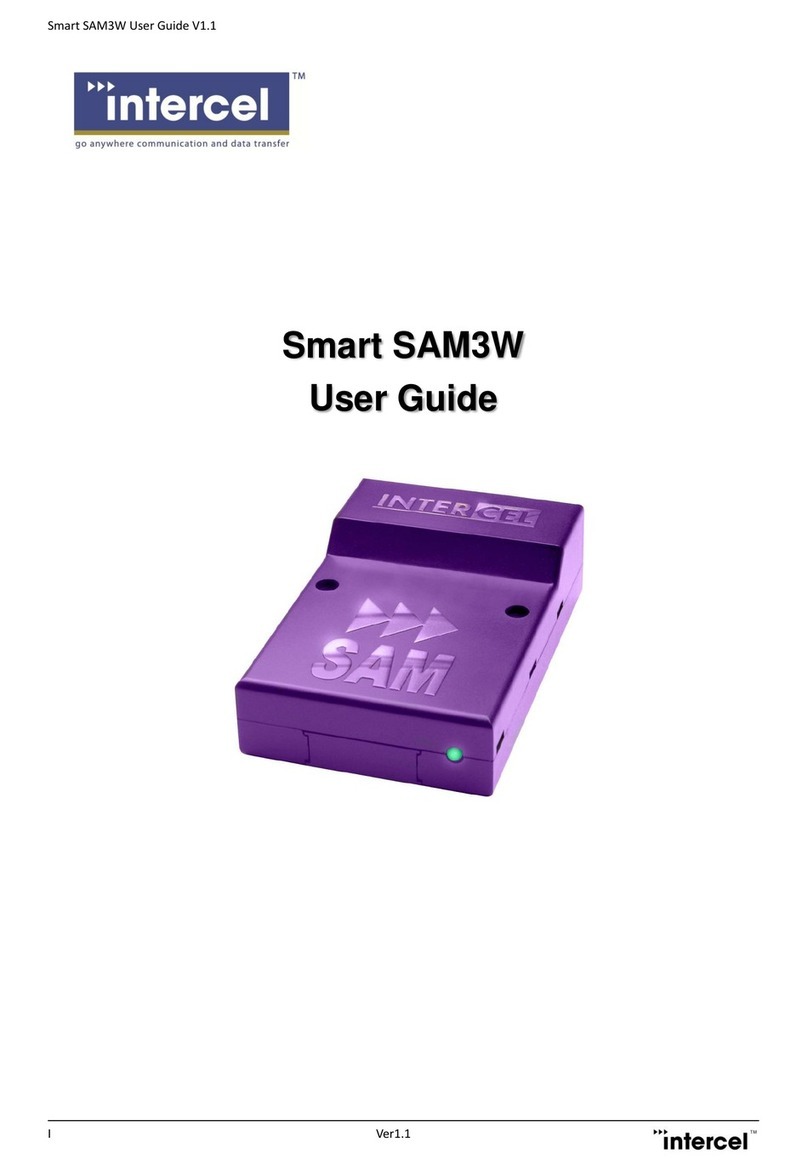
Intercel
Intercel Smart SAM3W User manual

Intercel
Intercel Ultra eSAM User manual
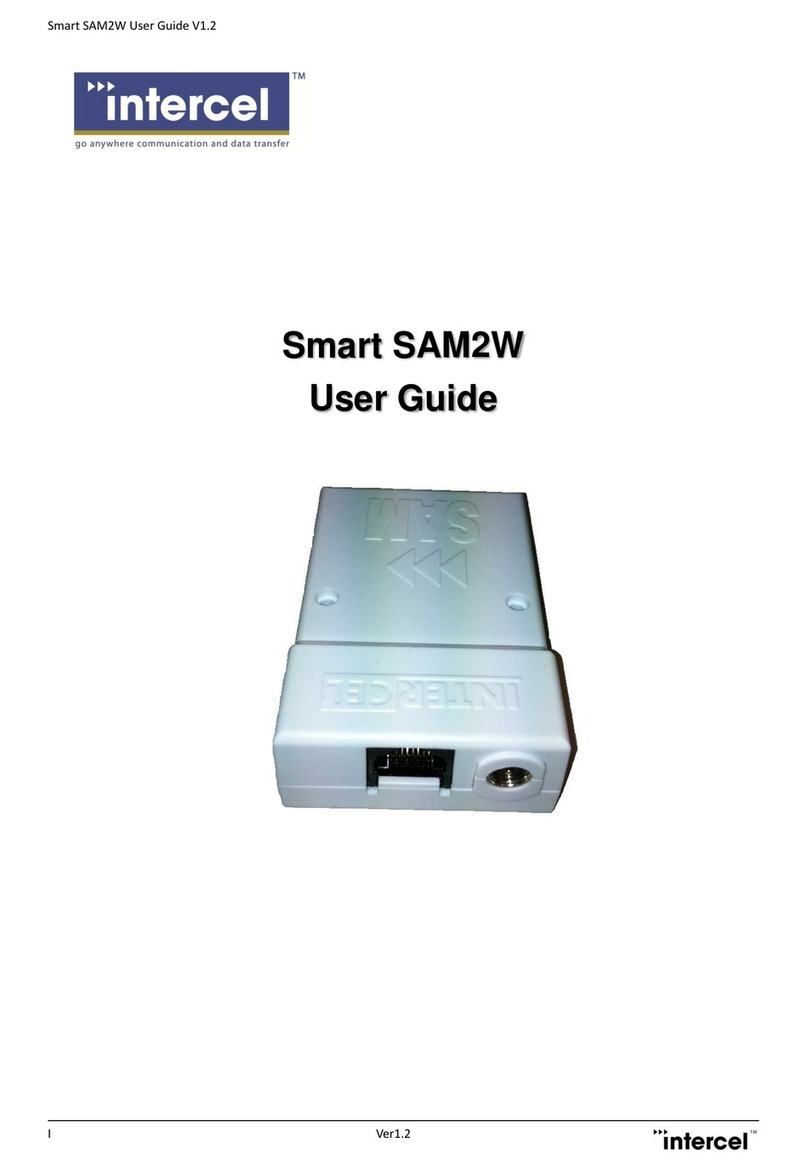
Intercel
Intercel Smart SAM2W User manual

Intercel
Intercel eSAM User manual
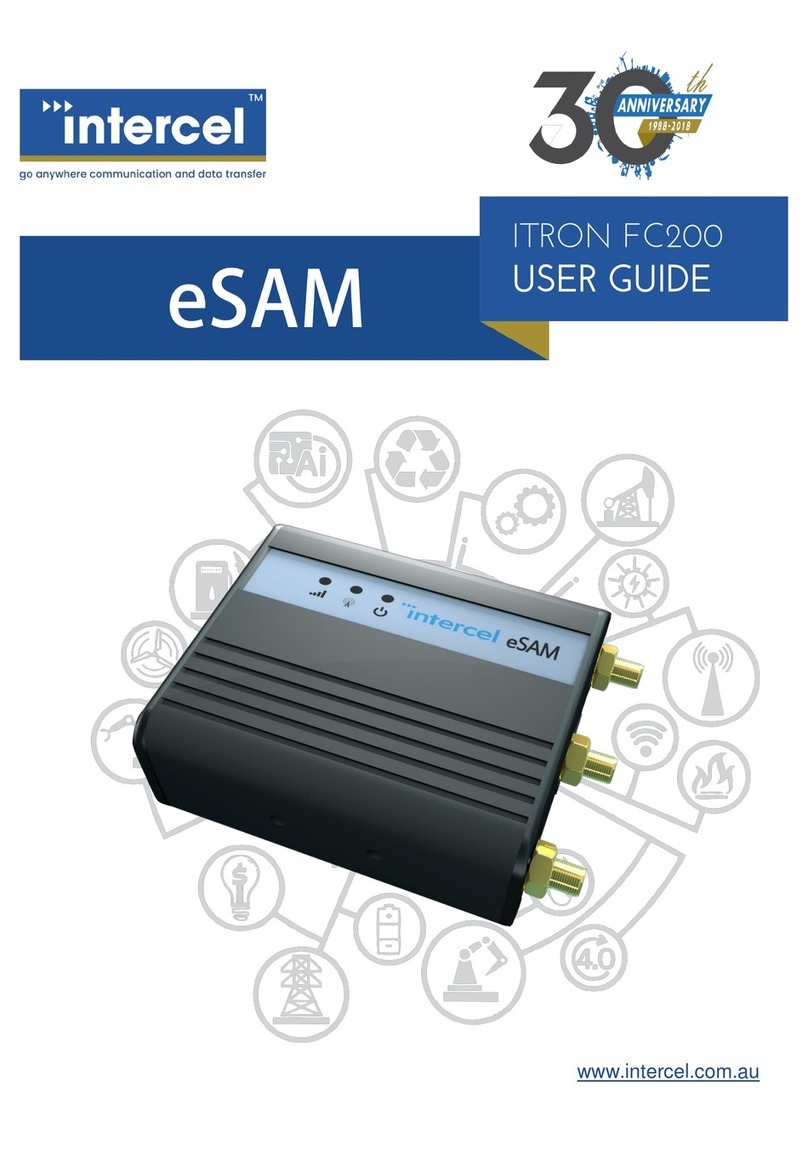
Intercel
Intercel eSAM ITRON FC200 User manual
Popular Modem manuals by other brands
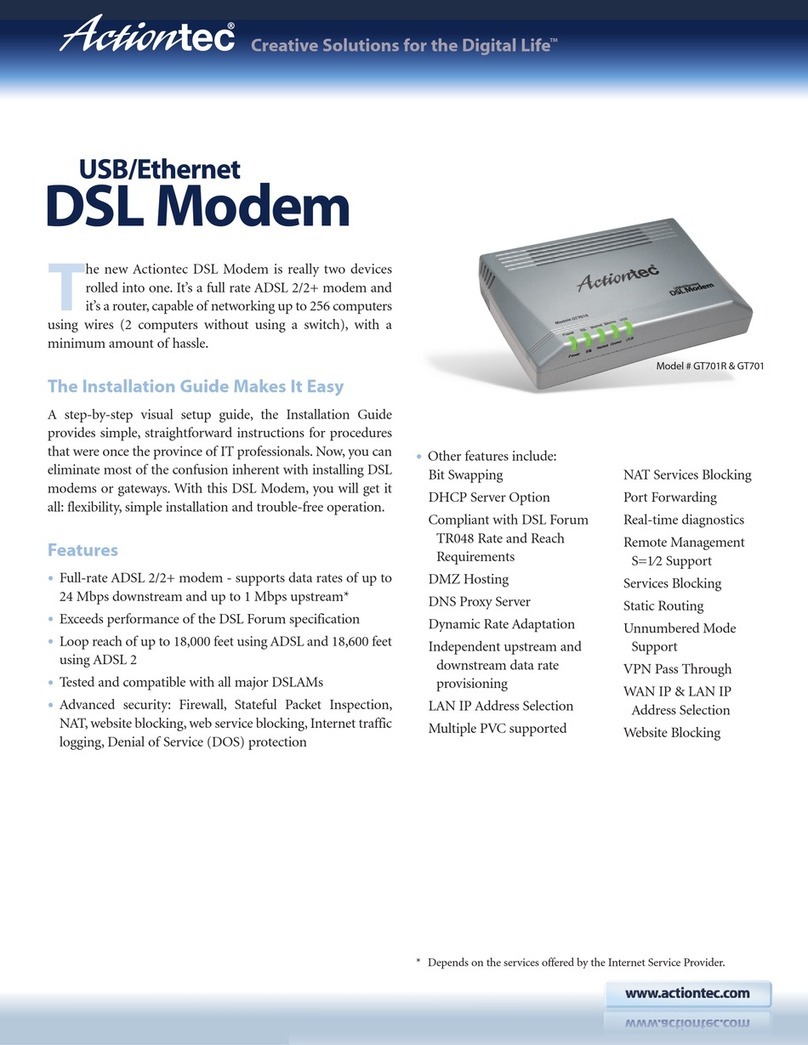
ActionTec
ActionTec GT701R Technical specifications
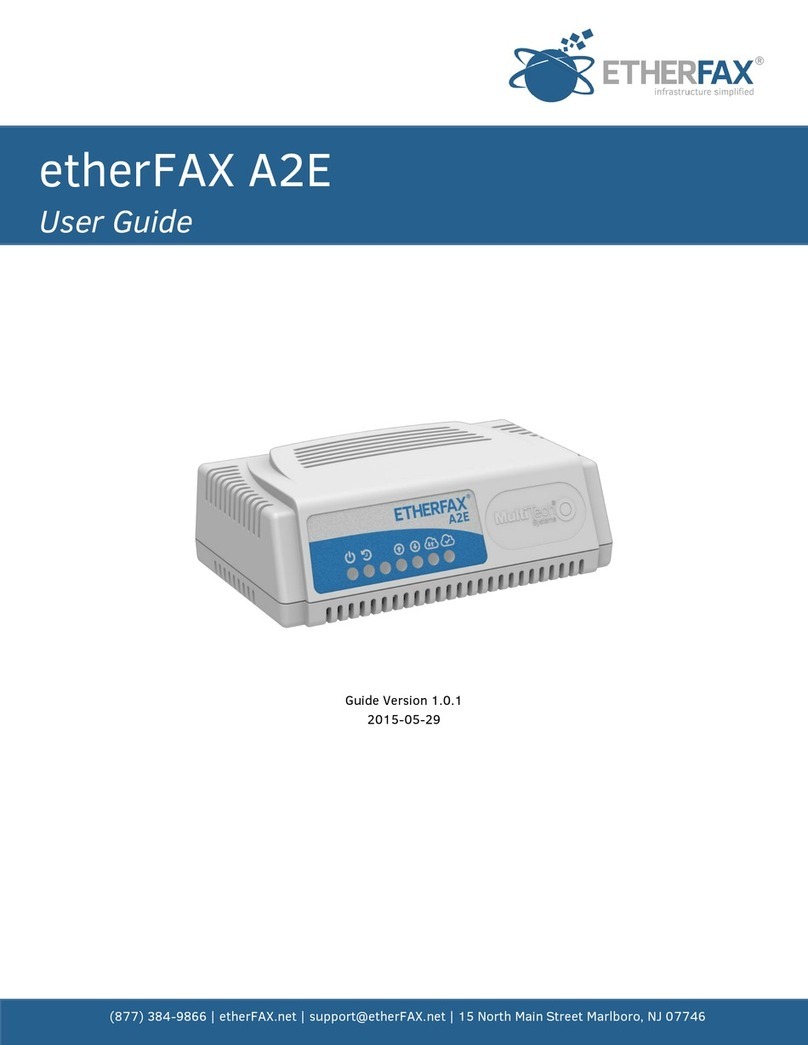
etherFAX
etherFAX A2E user guide
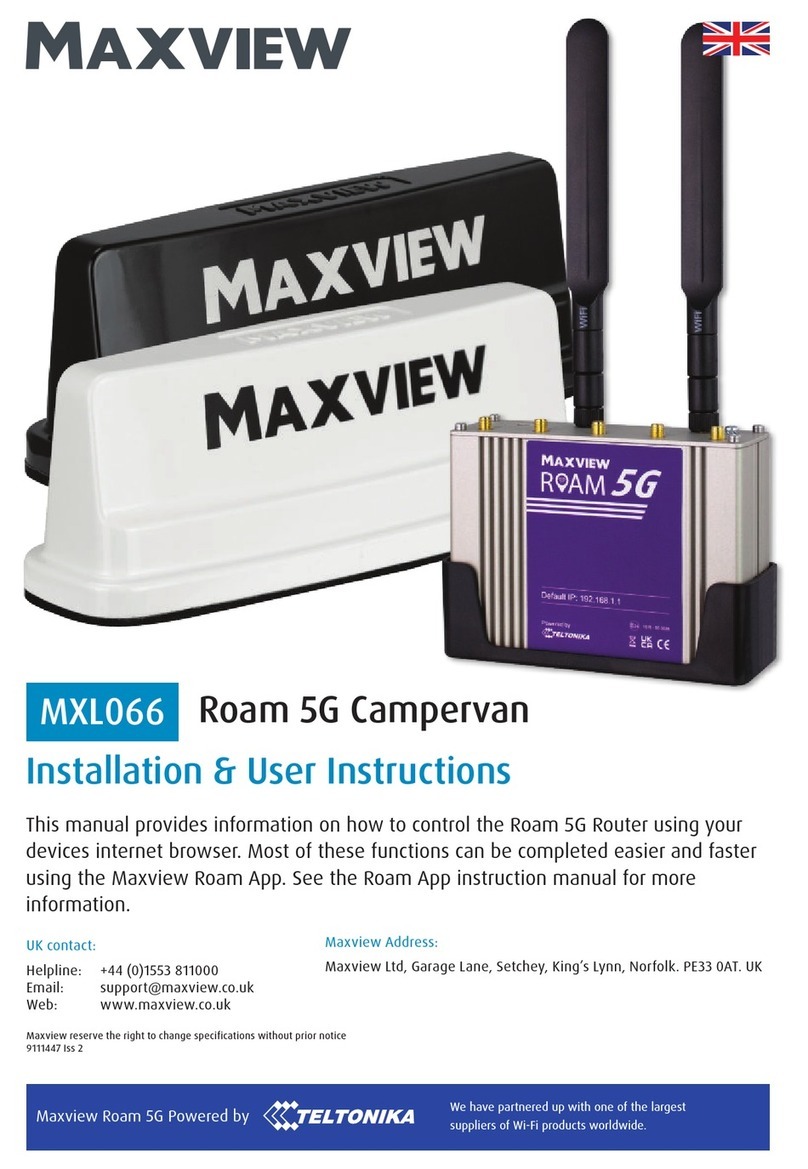
Teltonika
Teltonika Maxview MXL066 Installation & user's instructions
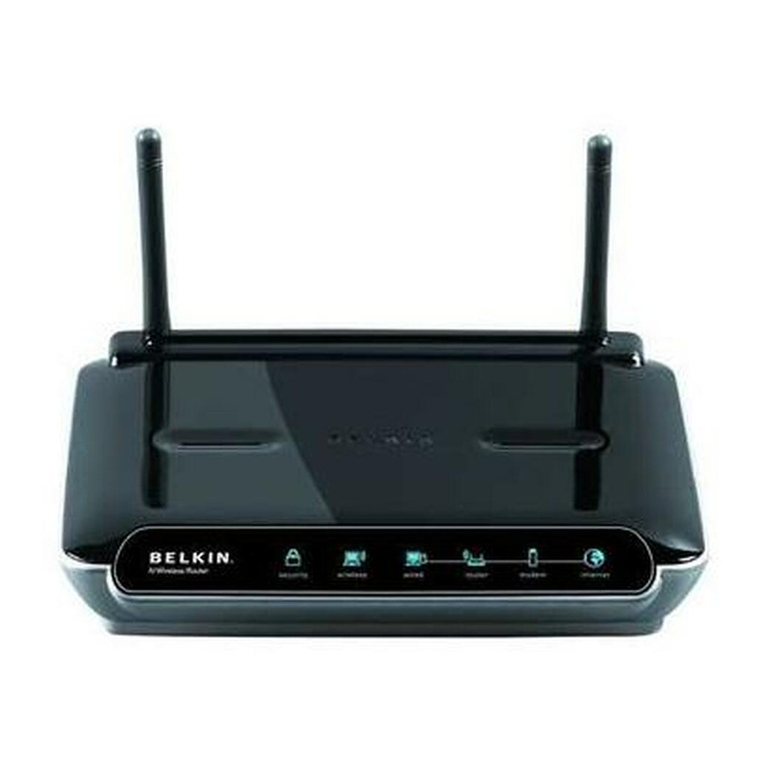
Belkin
Belkin ADSL Modem with Wireless-G Router F5D7632UK4 user manual
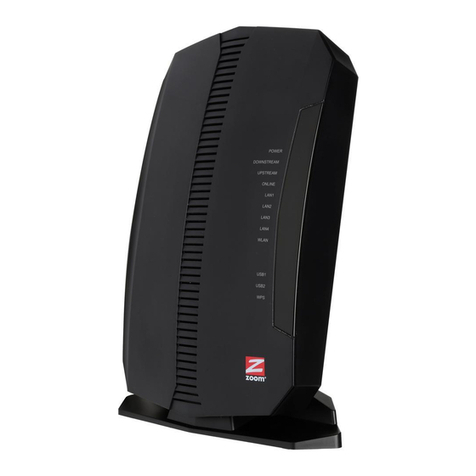
Zoom
Zoom 5354 user manual
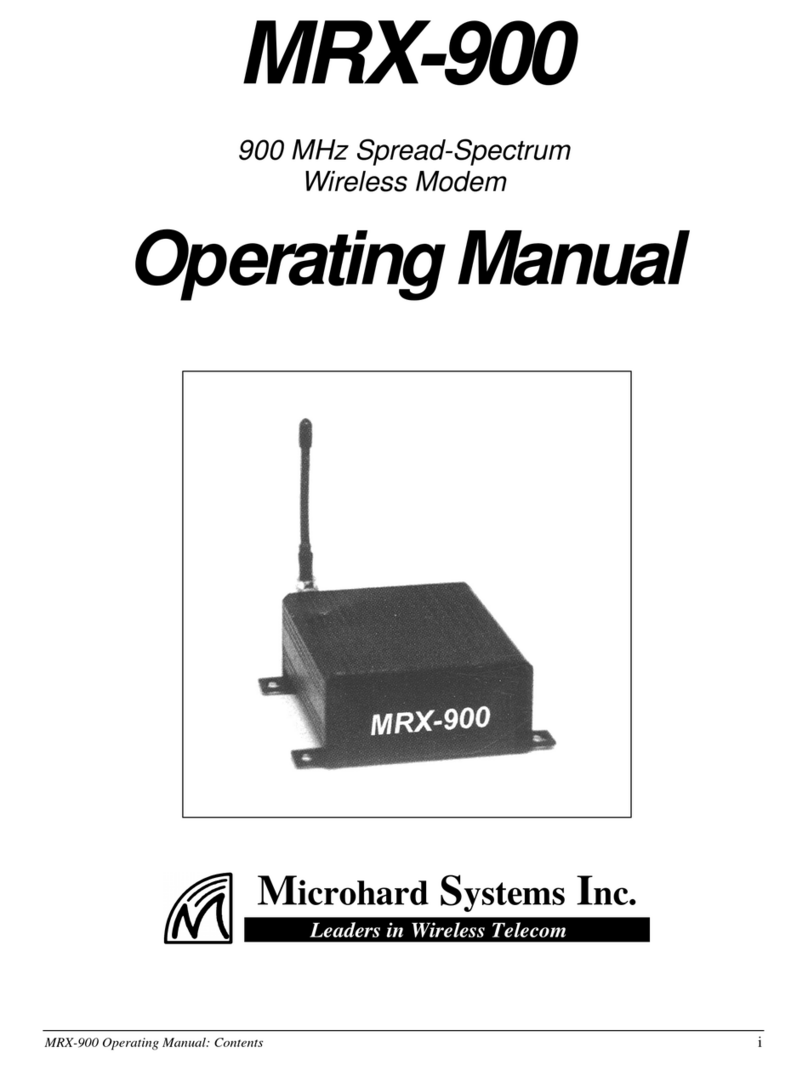
Microhard Systems
Microhard Systems MRX-900 operating manual
